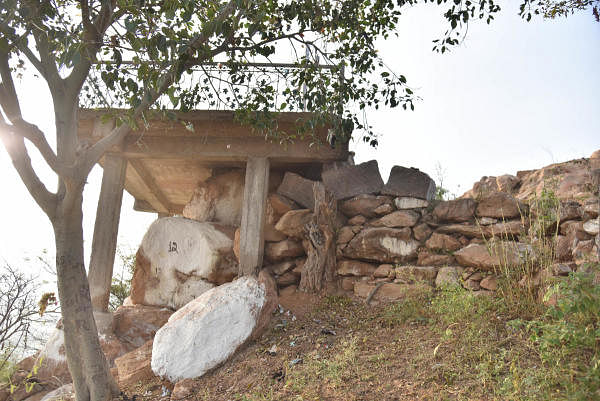
Standing atop the Kapala Betta, situated near Harobele village in Kanakapura, one gets a glimpse of Arkavathi river on one side and hill ranges dotting Ramanagara on the other.
The breeze brings a faint melody of hymns being sung at a Chapel in a nearby village. “Tuesday is Infant Jesus feast,” a local informs. A prototype Jesus statue stands on the peak, where eventually the proposed statue will come up. Some feet away is a Cross, which locals claim is at least 250 years old.
The hill and this statue are now caught in a controversy with Hindutva outfits claiming that Christian missionaries, supported by Congress leader D K Shivakumar, are appropriating the place known as Muneshwara Hill, sacred to Hindus.
One has to trek to the peak of the hill to pray to the Cross. On this path are 14 shrines of Jesus, portraying the various events leading to his crucifixion, ending in his resurrection later. The proposed statue, locals say, is supposed to depict the 15th stage of victory, after Jesus resurrects himself.
The controversy began when the ruling BJP and other Hindu groups said the Jesus statue was coming up at the cost of occupying a sacred place for Hindus. After a visit to the hill on Monday, RSS leader Kalladka Prabhakar Bhat alleged that stone slabs belonging to the Muneshwara temple were being used for the Jesus statue.
Claim disputed
However, locals have a different story to tell. “There was no Muneshwara temple here. The Cross atop the hill, which has existed from at least 1906, was originally placed between two rocks. As devotees began to increase, we put a platform around it. For the support of the platform, we have used stone slabs available on the hill,” explained Sandesh, a resident of Harobele.
He and a few others said the platform was put around 1999 and they themselves had carried whatever stones they could to make way for the platform.
The Kapala Betta is sacred for everyone in the surrounding areas, locals said. Bhadregowda, a resident of Mullahalli, flaunts a Rudraksha and a Cross around his neck. “I am a Hindu, but I come here regularly to pray to Jesus, apart from offering prayers to Lord Shiva. The local belief is that, one candle lit here can take care of all personal problems,” he narrated. Bhadregowda has contributed Rs 1 lakh to build the Jesus statue here.
Contrary to the claims of political outfits, locals say that the Muneshwara Hill was different from Kapala Hill. “The Muneshwara Hill is at least three km from here. There is a Muneshwara temple atop the hill,” said Ramesh, another local who works as a driver.
Locals added that Kapala Betta was surrounded by three hills with temples dedicated to Muneshwara, Kabbalamma and Shivaaladappa.
Harmonious living
Echoing the sentiments of several other locals, Chinnappa, a Harobele resident, alleged that the entire controversy was being blown out of proportion without considering the local sentiments. “Talk to us. You will find out that none of us have a problem with either Jesus or Lord Shiva. We are living in harmony here. Let us be.”
Bhat, however, said the locals were “ignorant” and “unable to understand” that they were being tricked by political leaders.
